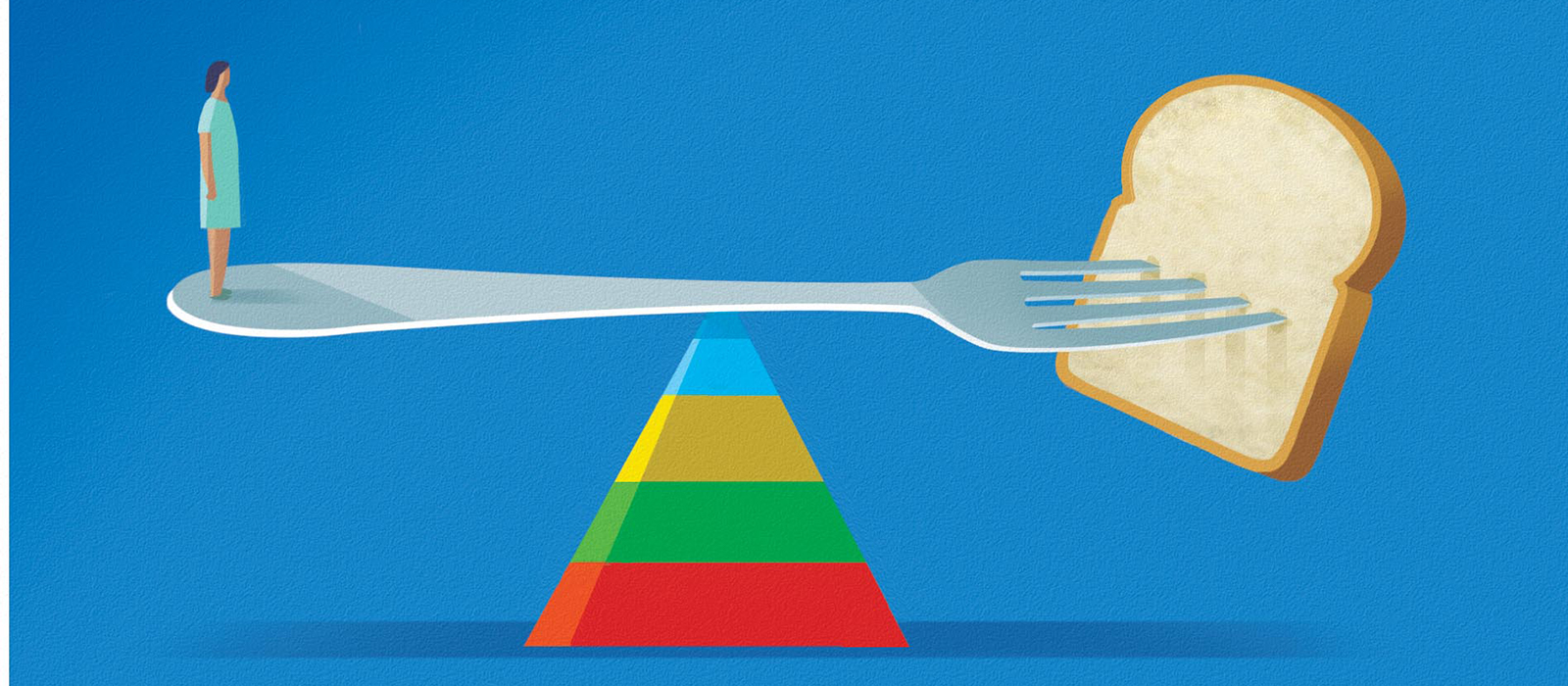Malnutrition affects 30%–85% of all patients with cancer, making it one of the most common symptoms for oncology nurses to manage. To help patients achieve the best outcomes, clinicians must understand how and when to screen for malnutrition and how nutritional status affects treatment outcomes and patients’ quality of life.

Although age, disease site, and stage influence risk, about 40% of pediatric patients with cancer, 80% of patients with gastrointestinal cancer, 40% of patients with lung cancer, and 42% of patients older than 78 are malnourished.
“Any patient with cancer may be at risk for malnutrition, regardless of their treatment modality. However, certain cancer diagnoses like head and neck, lung, and colorectal cancers are associated with higher rates of malnutrition,” ONS member Toby Bressler, PhD, RN, OCN®, FAAN, assistant professor of medical oncology at Icahn School of Medicine and senior director of nursing for oncology and clinical quality at Mount Sinai Health System, both in New York, NY, and member of the New York City ONS Chapter, said.

What Constitutes Malnourishment?
Bressler explained that malnutrition is classified on a scale from moderate to severe. The American Society for Parental and Enteral Nutrition’s diagnostic criteria classifies malnutrition into three distinct contexts: acute, chronic, and social-environmental. Acute malnutrition lasts three months or fewer, whereas chronic malnutrition lasts three months or longer. Social-environmental malnutrition is a chronic deficiency caused by factors like living environment, debility or illness, medication nonadherence, or lack of social support.
Some studies have linked hand grip strength to malnutrition, but the most significant warning sign of malnutrition is weight loss—even in patients who still appear to be at a healthy weight after weight loss.
“A malnourished patient has lost at least 10% of their total body weight over the previous six months,” ONS member Barbara Barnes Rogers, CRNP, MN, AOCN®, ANP-BC, nurse practitioner at Fox Chase Cancer Center in Philadelphia, PA, and member of the Bucks Montgomery Counties ONS Chapter, said. “An obese person who’s lost more than 10% of their body weight in six months might look healthy based on societal beauty standards. However, regardless of what weight they are at currently, we know that significant weight loss over a short period of time puts all patients at increased risk for poor outcomes.”
Bressler added that malnourished patients are those who meet less than 75% of their estimated nutrition needs, based on height, weight, and activity, for at least one month.
Malnutrition is associated with poor outcomes, including higher infection rates, longer hospitalizations, and suboptimal treatment responses, Bressler and Rogers explained. It also increases the risk of reduced functional status and treatment adverse events.
“I think that most nurses are aware that malnourished patients have worse outcomes,” Rogers said. “So we need to constantly assess a patient’s status, ability to eat, and fluid intake. We have to navigate barriers and enablers to the identification and management of malnutrition in our patients, including lack of knowledge and skills and confidence in performing the nutrition assessments along with having adequate time to complete the assessments.”
The Interplay of Treatment and Nutrition
Cancer treatments and their side effects can alter how the body absorbs, digests, and uses food. Inversely, malnutrition and weight loss can lead to treatment disruptions or delays.
“Chemotherapy drugs like cisplatin that have a high emetic risk are most likely to affect a patient’s ability to eat,” Rogers said. “The combination of chemotherapy and radiation can lead to complications in areas involved in food intake, such as esophagitis in patients with esophageal cancer, that also influences nutrition.”
Bressler added that malnutrition can cause chemotherapy-induced toxicities and other treatment complications like cachexia. Up to 80% of patients with advanced cancer experience complete loss of appetite, but dietary management strategies can improve outcomes.
“Nutrition interventions for patients who are at risk for malnutrition have been found to improve nutritional status and positively affect treatment-related outcomes,” Bressler said.
The American Society of Clinical Oncology recommended dietary counseling and avoiding the use of enteral feeding tubes and parenteral nutrition to manage cancer cachexia. Researchers found that oral nutrition supplements, fish oil supplements, and dietary counseling improved appetites for adult patients undergoing chemotherapy, radiotherapy, and immunotherapy.
Managing symptoms with fluids and antiemetics may help to improve patients’ appetite, or pharmaceuticals may be an option. “We currently have three primary appetite stimulants available,” Rogers said. “First is megestrol acetate. It’s a hormone, so keep that in mind when prescribing or managing patients who are receiving it. Second, we have cannabinoids, and third we have corticosteroids, which work for shorter durations because of side effects with longer use, such as steroid-induced diabetes.”
Screening for Malnutrition
Bressler and Rogers agreed that early intervention is crucial to maintaining healthy nutritional status.
“Early detection provides an opportunity to intervene before severe or irreversible malnutrition occurs,” Bressler said. “In all of our health system’s ambulatory infusion practices, nurses assess each patient for malnutrition at their first antineoplastic infusion appointment.”
The simplest way to assess nutritional status is to monitor a patient’s weight loss, Rogers said, and validated screening tools, including Nutritional Risk Screening and Scored Patient-Generated Subjective Global Assessment, have been shown to improve outcomes.
Bressler uses the Malnutrition Screening Tool, a validated and noninvasive questionnaire built into her institution’s electronic medical record system.
“The combination of these interventions should be individualized based on patient needs, the expected effect from their malignancy, and their specific cancer treatment,” Rogers said. “Broader use of these tools could help clinicians better identify patients at risk for malnutrition. Once clinicians identify risk, it’s important to complete a comprehensive nutrition assessment, including evaluation of body composition and muscle mass.”
Involve the Interprofessional Team
Bressler coauthored a 2020 study, published in the Clinical Journal of Oncology Nursing, in which her research team found that collaboration between nursing and nutrition department leaders resulted in the best outcomes for malnutrition screening and management. Each member of the care team has a vital role.
“Oncology nurses, nurse practitioners, physician assistants, and physicians are responsible for identifying symptoms and side effects that may lead to malnutrition, such as decreased appetite and oral changes,” she said. “At times, the team may prescribe medications to manage them, so pharmacy plays a role, too. The nursing and medical team can also refer at-risk patients to an oncology-registered dietitian for a nutrition-focused physical exam and assessment.”
An interprofessional nutrition support team (NST)—a director, a dietitian, a nurse, and a pharmacist—has been shown to improve patient safety and outcomes and have a positive financial impact on institutions. Physicians assist in diagnosing malnutrition, managing prescriptions, and implementing policies and procedures, and oncology nurses identify and provide ongoing assessment for malnourished patients.
“Oncology nurses have frequent contact with patients during treatment, which helps us develop therapeutic relationships,” Bressler said. “So nurses are crucial to bridging the gaps in education and collaborating with the rest of the healthcare team to prevent and manage malnutrition.”
Management Involves Patient and Caregiver Education
Patients must understand how their diagnosis and treatment regimen affects their ability to eat and absorb nutrients. Rogers tells patients to drink plenty of fluids and notify their provider if they experience trouble eating or drinking.
If their appetite does decline, Rogers tells her patients to keep trying foods they used to find appetizing because they will experience frequent taste changes. She also encourages caregivers to cook in smaller amounts to prevent frustration over wasted food after the patient declines eating something they enjoyed in the past.
Some patients or caregivers may think weight loss is a positive side effect, particularly if they began treatment at an obese BMI, but “we have to make sure we tell patients that during treatment is not the time to try to lose weight,” Rogers said.
Patient education information is available through organizations like the American Cancer Society and Oncology Nutrition Dietetic Practice group, and ONS has guides for nurses, Rogers said, such as courses and podcasts.
“Nutrition is an ongoing issue for patients with cancer,” Rogers said. “Something I learned early on in my oncology career is that no two patients are alike when it comes to nutrition and the interventions that will be successful in maintaining their nutritional status. The type of foods patients can tolerate and find appetizing vary greatly, but by listening to the patient we can help them come up with ways to maintain a healthy intake of food and fluids.”






